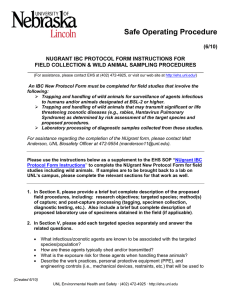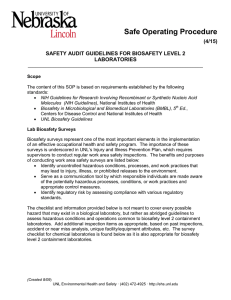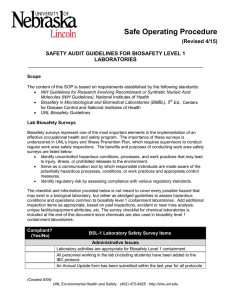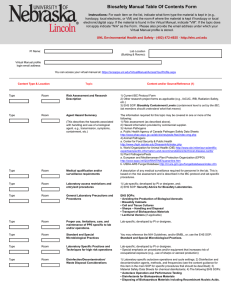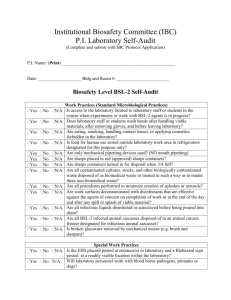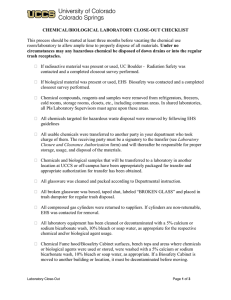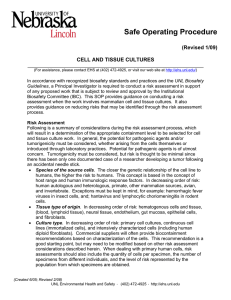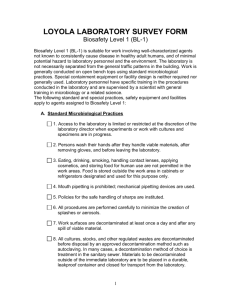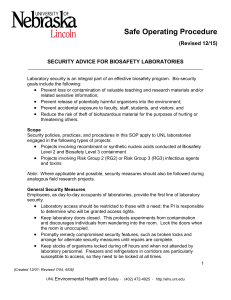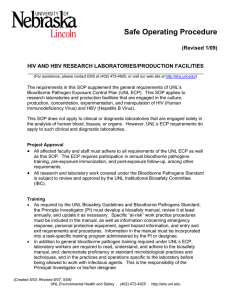Safe Operating Procedure (Revised 12/15) STANDARD AND SPECIAL MICROBIOLOGICAL PRACTICES
advertisement
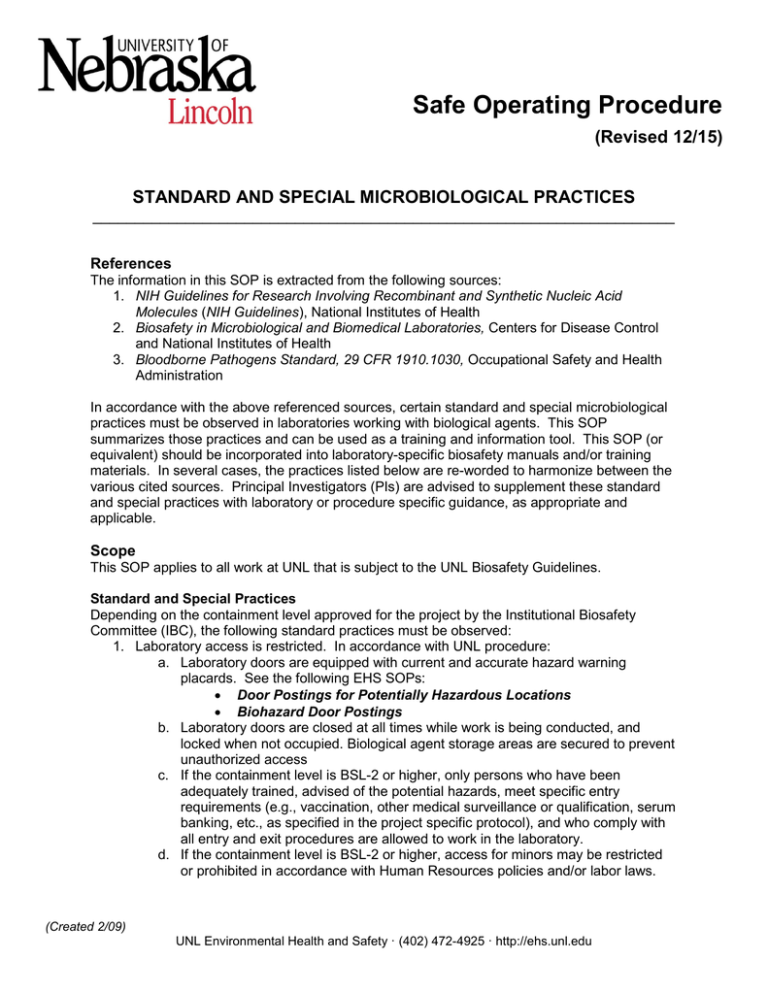
Safe Operating Procedure (Revised 12/15) STANDARD AND SPECIAL MICROBIOLOGICAL PRACTICES _____________________________________________________________________ References The information in this SOP is extracted from the following sources: 1. NIH Guidelines for Research Involving Recombinant and Synthetic Nucleic Acid Molecules (NIH Guidelines), National Institutes of Health 2. Biosafety in Microbiological and Biomedical Laboratories, Centers for Disease Control and National Institutes of Health 3. Bloodborne Pathogens Standard, 29 CFR 1910.1030, Occupational Safety and Health Administration In accordance with the above referenced sources, certain standard and special microbiological practices must be observed in laboratories working with biological agents. This SOP summarizes those practices and can be used as a training and information tool. This SOP (or equivalent) should be incorporated into laboratory-specific biosafety manuals and/or training materials. In several cases, the practices listed below are re-worded to harmonize between the various cited sources. Principal Investigators (PIs) are advised to supplement these standard and special practices with laboratory or procedure specific guidance, as appropriate and applicable. Scope This SOP applies to all work at UNL that is subject to the UNL Biosafety Guidelines. Standard and Special Practices Depending on the containment level approved for the project by the Institutional Biosafety Committee (IBC), the following standard practices must be observed: 1. Laboratory access is restricted. In accordance with UNL procedure: a. Laboratory doors are equipped with current and accurate hazard warning placards. See the following EHS SOPs: • Door Postings for Potentially Hazardous Locations • Biohazard Door Postings b. Laboratory doors are closed at all times while work is being conducted, and locked when not occupied. Biological agent storage areas are secured to prevent unauthorized access c. If the containment level is BSL-2 or higher, only persons who have been adequately trained, advised of the potential hazards, meet specific entry requirements (e.g., vaccination, other medical surveillance or qualification, serum banking, etc., as specified in the project specific protocol), and who comply with all entry and exit procedures are allowed to work in the laboratory. d. If the containment level is BSL-2 or higher, access for minors may be restricted or prohibited in accordance with Human Resources policies and/or labor laws. (Created 2/09) UNL Environmental Health and Safety · (402) 472-4925 · http://ehs.unl.edu 2. Good personal hygiene practices are observed. a. Eating, drinking, smoking, handling contact lenses, applying cosmetics, and storing food for human consumption are not permitted in the laboratory. b. Persons wash their hands: after handling potentially infectious materials, r/sNA molecules, and/or animals, and; before exiting the laboratory. c. Mechanical pipetting devices are used; mouth pipetting is prohibited. 3. Appropriate Personal Protective Equipment (PPE) is available and used. a. If the containment level is BSL-2 or higher, laboratory coats, gowns, smocks, or uniforms are worn while in the laboratory, and removed before exiting the laboratory. b. Appropriate protective gloves are used when contact with r/sNA, infectious materials, and/or animals is likely. Gloves are changed when contaminated, integrity has been compromised, or when otherwise necessary. Hands are washed after removing gloves, before touching clean surfaces, before exiting the laboratory, and before donning new gloves. Disposable gloves are not reused and are managed as potentially contaminated laboratory waste. c. For HIV and HBV laboratories, solid front or wrap-around gowns, scrub suits, or coveralls are worn in the laboratory. PPE is not worn outside the laboratory, and it is decontaminated prior to laundering and disposal, as necessary. d. Eye protection is used. Goggles may be required if there is substantial risk of splashes and/or aerosols. Additional PPE may be required for special tasks or additional hazards (e.g., chemical, radiation, etc.). Eye and face protection must be disposed of with other contaminated laboratory waste or decontaminated before reuse, as necessary. 4. Disinfection and decontamination. a. Work surfaces are decontaminated at the completion of each day’s work session and after any spill of potentially infectious materials with appropriate disinfectant (as specified in the applicable protocol). b. Laboratory equipment is routinely decontaminated as well as after spills, splashes, or other potential contamination. Equipment is decontaminated before repair, maintenance, or removal from the laboratory. c. An emergency plan must be developed and include response to spills involving biological agents. Such spills must be promptly contained, decontaminated, and cleaned up. Laboratory staff must be trained on the plan, competent to clean-up spills, and have appropriate spill clean-up materials readily available. See EHS SOP, Spill and Exposure Response for Biohazardous Materials (including Recombinant or Synthetic Nucleic Acids). d. All contaminated liquid or solid wastes are decontaminated before disposal. Contaminated materials that are to be decontaminated at a site away from the laboratory are placed in a durable leak-proof container which is closed before being removed from the laboratory. Materials to be transported by public highways or roads for off-site decontamination are packaged by persons with current training in DOT/IATA transport regulations. See EHS SOPs regarding shipping. 5. All procedures are performed carefully to minimize the creation of splashes and aerosols. For BSL-2, all activities anticipated to present a splash or aerosol hazard are conducted in biological safety cabinets or other physical containment devices. For HIV and HBV labs, all work with open vessels will be conducted in a biosafety cabinet (not on the open bench). (Created 2/09) UNL Environmental Health and Safety · (402) 472-4925 · http://ehs.unl.edu 6. Use of sharps (e.g., needles, scalpels, pipettes, glassware) is avoided. Plastic-ware is substituted for glassware whenever possible. a. When absolutely necessary, the following general precautions are taken. • Needles are not bent, sheared, broken, recapped, removed from disposable syringes, or otherwise manipulated by hand before disposal. • Used sharps are carefully placed in puncture-resistant containers. • Broken glassware is not handled directly. Instead, it is handled using mechanical assistance (e.g., brush and dustpan, tongs, forceps). • Effective hand protection is used (e.g., molded guards, use of forceps when using scalpels, etc.). b. If the containment level is BSL-2 or higher, hypodermic needles and syringes are used only for parenteral injection and aspiration of fluids from laboratory animals and diaphragm bottles. Only needle-locking syringes or disposable syringeneedle units (i.e., needle is integral to the syringe) are used. Extreme caution is used when handling needles and syringes to avoid autoinoculation and the generation of aerosols during use and disposal. 7. If the containment level is BSL-2 or higher, emergency action procedures are available that include immediate reporting of spills and accidents that result in overt exposures to the Principal Investigator (PI) and EHS. Medical evaluation is sought immediately. See EHS SOP, On the Job and Student Injuries. In some cases, reporting to regulatory authorities may be required. See EHS SOP, Incident Reporting – National Institutes of Health (NIH) Guidance. 8. An effective rodent and insect control program is observed. Signs of infestation are immediately reported to the Principal Investigator (PI) and action taken to impede incursion. If the containment level is BSL-2, animals and plants unrelated to the work are not permitted in the work area. 9. For HIV and HBV laboratories, vacuum lines are protected with high efficiency particulate air/HEPA filters and liquid disinfection traps, which are checked routinely and maintained or replaced as necessary. 10. A laboratory-specific biosafety manual is available and accessible to laboratory personnel. Laboratory personnel are trained to the laboratory specific manual, demonstrate proficiency in standard and special microbiological practices, receive appropriate training regarding their duties, the necessary precautions to prevent exposures, and exposure evaluation procedures. These procedures are included in the laboratory emergency action plan. See EHS SOP, Preparing a Laboratory Biosafety Manual. 11. Personnel receive annual updates and additional training when procedural or policy changes occur. 12. Personnel are advised that personal health status may impact an individual’s susceptibility to infection, and their ability to receive immunizations or prophylactic interventions. Personnel are encouraged to self-report conditions that may impact their immune competence or predispose them to infection so that they may seek counseling and guidance from UNL’s healthcare provider (Created 2/09) UNL Environmental Health and Safety · (402) 472-4925 · http://ehs.unl.edu
